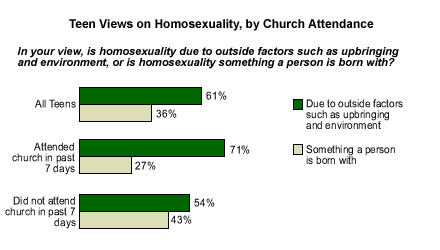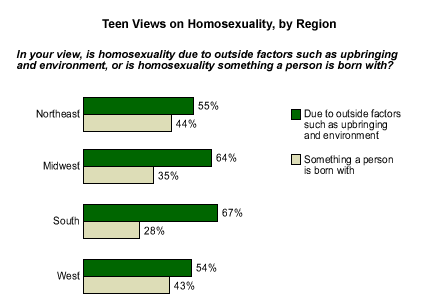The question of nature or nurture stands at the very center of many complex issues. Why, for instance, do some children perform better on standardized tests than others do? What causes some Americans to be overweight, while others never gain an ounce? But nowhere is the uncertainty of nature versus nurture more widely discussed than in issues surrounding human sexuality.
In the 2003 ���۴�ýYouth Survey, ���۴�ýasked teens (aged 13 to 17), "In your view, is homosexuality due to outside factors such as upbringing and environment, or is homosexuality something a person is born with?" A majority of teens (61%) think that outside factors are the key to homosexuality. Just over a third (36%) feel that sexual orientation is an innate characteristic, much like being right-handed or left-handed.
Contrast the teen results with data from ���۴�ýPolls that suggest that U.S. adults are more divided on the question, with nearly equal proportions saying homosexuality is something people are born with and saying it is due to environmental factors.
Teens who attended church or synagogue in the last seven days are more disposed to the "nurture" theory than are those who did not attend a church service in the past week. Seventy-one percent of teens who have attended church in the last seven days say it is due to upbringing and environment (27% say it is something people are born with). A majority of those who did not recently attend church, 54%, also says it is due more to environmental factors, but a substantial minority of this group, 43%, says it is something people are born with. High levels of religiosity often are correlated to more conservative views on social issues such as homosexuality.

Political Affiliations
While respondents to this survey are not yet able to vote, the Youth Survey asked them how they plan to vote when they're old enough. Seventy-two percent of those teens identifying with the Republican Party believe homosexuality is a result of outside factors, versus 56% of future Democrats, and 59% of teens who say they will be independents.
This is a slightly different pattern than that observed among adults, at least among Democrats. A majority of adult Democrats generally believe homosexuality is something people are born with, while these data suggest most teen Democrats believe it is due to environmental factors.

Regional Differences
Teens' views on homosexuality tend to mirror familiar conservative/liberal patterns when it comes to regional differences, as well. Just over half of all teens living in the Northeastern and Western regions of the United States, 55% and 54%, respectively, feel that outside factors are responsible for a tendency toward homosexuality, compared to 64% of Midwestern teens and 67% of Southern teens.

Bottom Line
When it comes to complex issues such as homosexuality, answers rarely come in black and white. We may never know for certain why some people are overweight and some aren't, and why some people are attracted to the opposite sex and others aren't. Dr. David S. Moore, professor of Psychology at Pitzer College, says it's not nature versus nurture -- it's both. In his book, The Dependent Gene, Moore says that traits are determined by the interaction of genetic and nongenetic factors, none of which is "more important than any other; instead, they are all collaborators."
In fact, younger Americans may soon consider this debate a non-issue. As suggested in "Acceptance of Homosexuality: A Youth Movement" (see Related Items), " . . . the scientific origin of homosexuality doesn't appear to make much difference to young adults -- they're more likely to be accepting of it either way."
*The ���۴�ýYouth Survey is conducted via an Internet methodology provided by Knowledge Networks, using an online research panel that is designed to be representative of the entire U.S. population. The current questionnaire was completed by 1,200 respondents, aged 13 to 17, between Jan. 23-Feb. 10, 2003. For results based on the total sample, one can say with 95% confidence that the maximum margin of sampling error is ±3%. For a complete description of the sampling and weighting procedures used to conduct the survey, click .